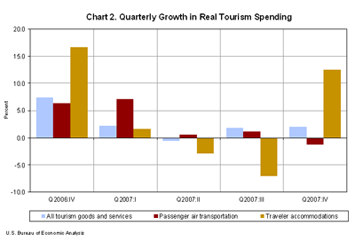* See the navigation bar at the right side of the news release text for links to data tables,
contact personnel and their telephone numbers, and supplementary materials.
Spending on tourism (adjusted for price changes) increased at an annual rate of 2.0 percent in 2007:4, according to the Bureau of Economic Analysis, reflecting a rise in spending on accommodations and food that was partly offset by a decrease in spending on transportation and entertainment. In 2007:3, spending on tourism grew 1.8 percent (revised). By comparison, real gross domestic product (GDP) grew at an annual rate of 0.6 percent (preliminary) in 2007:4 and 4.9 percent in 2007:3.
Spending on accommodations turned up strongly, increasing 12.5 percent in 2007:4 after decreasing in both 2007:2 and 2007:3. Prices for accommodations decreased 1.9 percent in 2007:4 after increasing an average of 11.1 percent the previous two quarters.
Spending on passenger air transportation decreased 1.3 percent in 2007:4 following small increases in 2007:2 and 2007:3. Prices for passenger air transportation increased 1.0 percent in 2007:4 after increasing an average of 10.7 percent the previous two quarters.

Employment supported directly by the spending of tourists rose 0.5 percent in 2007:3 (the most recent period for which data are available), the same rate as in 2007:2. By comparison, overall U.S. employment grew 0.8 percent in 2007:3 after 0.9 percent growth in 2007:2.
Also:
- For the year 2007, spending on tourism grew 2.1 percent, continuing a reduction in growth since the peak in 2004.
- Spending on food and drink grew 1.6 percent in 2007 following four consecutive years of growth above 4 percent.
- Spending on recreation, entertainment and shopping decreased 0.7 percent in 2007:4 following 4.2 percent growth in 2007:3.
- Prices for all tourism goods and services increased 4.6 percent in 2007:4 following a 5.0 percent increase (revised) in 2007:3.



Total Tourism-Related Spending. The U.S. production that tourism spending generates not only includes the goods and services that are purchased directly but also the inputs used to produce these goods and services—indirect tourism-related spending. In 2007:4, total current-dollar tourism-related spending of $1.3 trillion consisted of $757.6 billion (57 percent) of direct tourism spending—goods and services sold directly to visitors—and $576.7 billion (43 percent) of indirect tourism-related spending—goods and services used to produce what visitors buy.
Total Tourism-Related Employment. In 2007:3, total tourism-related employment of 8.7 million consisted of 5.9 million (69 percent) direct tourism jobs—jobs where workers produce goods and services sold directly to visitors—and 2.7 million (31 percent) indirect tourism-related jobs—jobs where workers produce goods and services used to produce what visitors buy.
Definitions
Tourism spending. Tourism spending comprises all goods and services purchased by tourists (defined as people who travel for any reason.). In the following tables, tourism spending is referred to as direct tourism output.
Indirect tourism-related spending. Indirect tourism-related spending comprises all output used as inputs in the process of producing direct tourism output (e.g., toiletries for hotel guests and the plastic used to produce souvenir key chains).
Total tourism-related spending. Total tourism-related spending is the sum of direct tourism spending and indirect tourism-related spending.
Direct tourism employment. Direct tourism employment comprises all jobs where the workers are engaged in the production of direct tourism output (such as hotel staff, airline pilots, and souvenir sellers).
Indirect tourism-related employment. Indirect tourism-related employment comprises all jobs where the workers are engaged in the production of indirect tourism-related output (e.g., employees of companies that produce toiletries for hotel guests and the plastic used to produce souvenir key chains).
Total tourism-related employment. Total tourism-related employment is the sum of direct tourism employment and indirect tourism-related employment.
These estimates are from the Travel and Tourism Satellite Accounts (TTSAs), which are supported by funding from the Office of Travel and Tourism Industries, International Trade Administration, U.S. Department of Commerce. The current-price estimates of direct tourism output were derived from BEA’s annual TTSAs (revised in June 2007) and current-dollar quarterly estimates of personal consumption expenditures from the NIPAs. The constant-price estimates of direct tourism output were developed using price indexes from the Bureau of Labor Statistics (BLS) and constant-price quarterly estimates of personal consumption expenditures from the NIPAs. The estimates of direct tourism employment were derived from the annual TTSAs (revised in June 2007) and the Quarterly Census of Employment and Wages from BLS. Employment data are available five to six months after the end of the reference quarter.
Quarterly estimates are expressed at seasonally adjusted annual rates, unless otherwise specified. Percent changes are calculated from unrounded data and annualized. “Real” estimates are in chained (2000) dollars. Price indexes are chain-type measures. Growth in overall U.S. employment is calculated using BLS Total nonfarm employment from Current Employment Statistics, www.bls.gov/ces/home.htm#data.
* * *
Next release – Travel and Tourism estimates for first quarter 2008 will be released on Wednesday, June 18, 2008 at 8:30 a.m. EDT.
BEA’s national, international, regional, and industry estimates; the Survey of Current Business; and BEA news releases are available without charge on BEA’s Web site at www.bea.gov. By visiting the site, you can also subscribe to receive free e-mail summaries of BEA releases and announcements.





